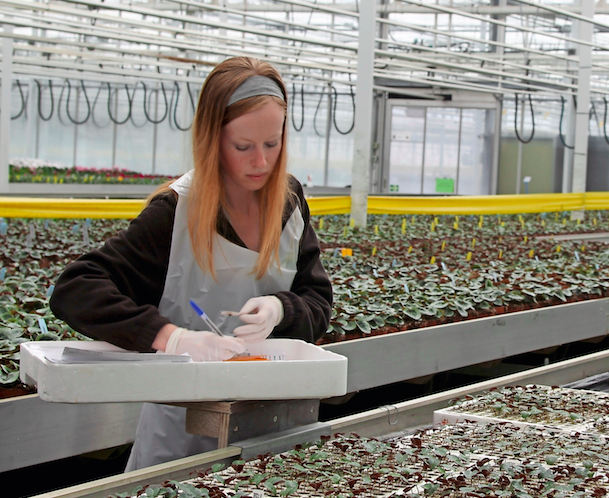Schoneveld Breeding’s services don’t stop with the supply of seed. Their focus is on collaborations throughout the entire chain, with the grower in central position. Touch Me and Addenda are prominent examples. The breeder is looking for similar partnerships for their other product groups.
By Peter van Leth
Schoneveld Breeding’s assortment consists of five product groups: cyclamen Super Series (75%), primula Touch Me and primula acaulis Paradiso (10%), ranunculus Sprinkles (10%) and campanula Florentes (5%). Some of their seed production happens in Tanzania to spread the risk and because it offers a better climate.
Getting growers involved
Schoneveld Breeding generally takes around 10 years to develop a new variety and gets growers closely involved during the last scaling-up phases of the process. “We aren’t the fastest breeder, but we want to be and remain successful with the products that we bring to the market. That’s why we do a lot of testing, especially together with growers that we know well”, explains commercial director Frans Peter Dechering.

Own cultivation advisers
This close contact with growers doesn’t end there, either. Schoneveld Breeding supports growers with regards to cultivation, marketing and sales advice.
“We were the first breeding company that started working with our own cultivation advisers. That was around 2008/2009. Initially just in the Netherlands, and nowadays everywhere we operate. With the help of product and marketing management, we want to link the right end customer, whether this is a florist, garden centre or retailer, to the trade and to growers. This results in very specific product-grower-market combinations. We’re trying to create a market for a novelty, even before the product is ready to be launched”, says Dechering.
As an example, he mentions their new cyclamen Super Series Djix. We decide together with growers how many seeds will be made available. “It makes the launch of this pot plant a joint effort, which leads to significantly better results.”
All product groups
Dechering feels that growers’ associations Touch Me and Addenda are prominent examples of how partnerships with the breeder can work in practice. Ideally, Schoneveld Breeding would like to see collaborations like this for all of its product groups.
Dechering thinks that at some stage, there might be a cyclamen growers’ association, similar to Touch Me.
However, the initiative must come from the growers themselves. “The independent position of a growers’ association is its strength. Our company plays an important, guiding role. With a commercial interest of course.”
No copycat
Schoneveld Breeding is currently experimenting with other crops. Any new crops will have to be a good fit for the company. They’ll basically have to be cold-loving, flowering pot plants, propagated from seed. Which crops they’re considering, Dechering won’t say. He does share that any crop they start with, will have to be a step forwards within the existing assortment, for example with regards to speed, sustainability or plant form.
“We aren’t a copycat. All our products must be of high quality and differentiate. And they must be profitable for the entire chain of course.”
If they are going to expand, they wouldn’t increase by more than double of the current five product groups. “Ten product groups seems to be a natural maximum for us. If we had more product groups than that, we would no longer be able to perfectly control all parts of the process. You can’t be the best in everything, so it’s important to make choices”, feels Dechering.
From ‘can grow’ to ‘may grow’
Developments and trends are different for the different crops. Generally speaking, you could say that the further north you get in Europe, the smaller the plant and pot size.
According to Dechering, cyclamen shows the most interesting developments. Maybe not for more imaginative forms or an extensive colour range, but certainly for the improvements in quality. Schoneveld Breeding asked all cyclamen breeders to participate in a joint quality project led by LTO Glaskracht and Royal FloraHolland.
“The quality that we deliver, especially during the winter months, must improve and that’s a joint responsibility. We, ourselves, might even take it a step further. By no longer cultivating fast summer varieties during winter for example. Decisions shouldn’t be based on what’s possible, but on what’s allowed.”
PlantXperience
By the end of this year, the breeder will leave its current location in Twello. Their new location, called Schoneveld Breeding PlantXperience, will be in nearby Wilp. Half of the 3-ha complex consists of greenhouses and the other half of other facilities such as a molecular and cell biological laboratory, seed processing, seed technology and research facilities and offices. The R&D expansion in particular, is really going to speed up their breeding activities.
PlantXperience wants to link research, education and industry. Education is going to have a prominent place. This is reflected in different things, including the continued training of (new) staff and the installation of a glass corridor all along the outer side of the building. It will allow visitors to see the company’s activities without having to put on protective clothing.





